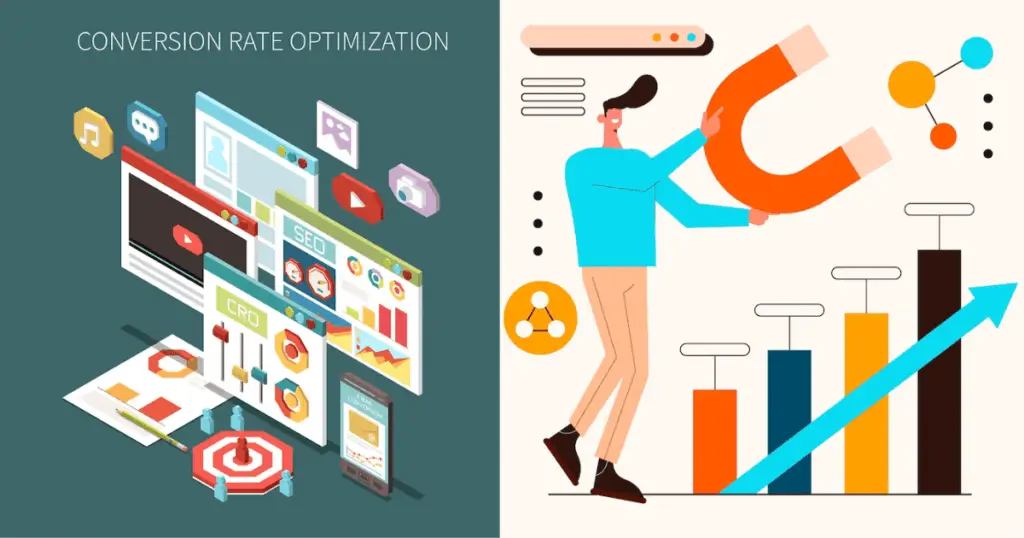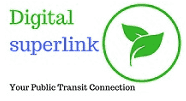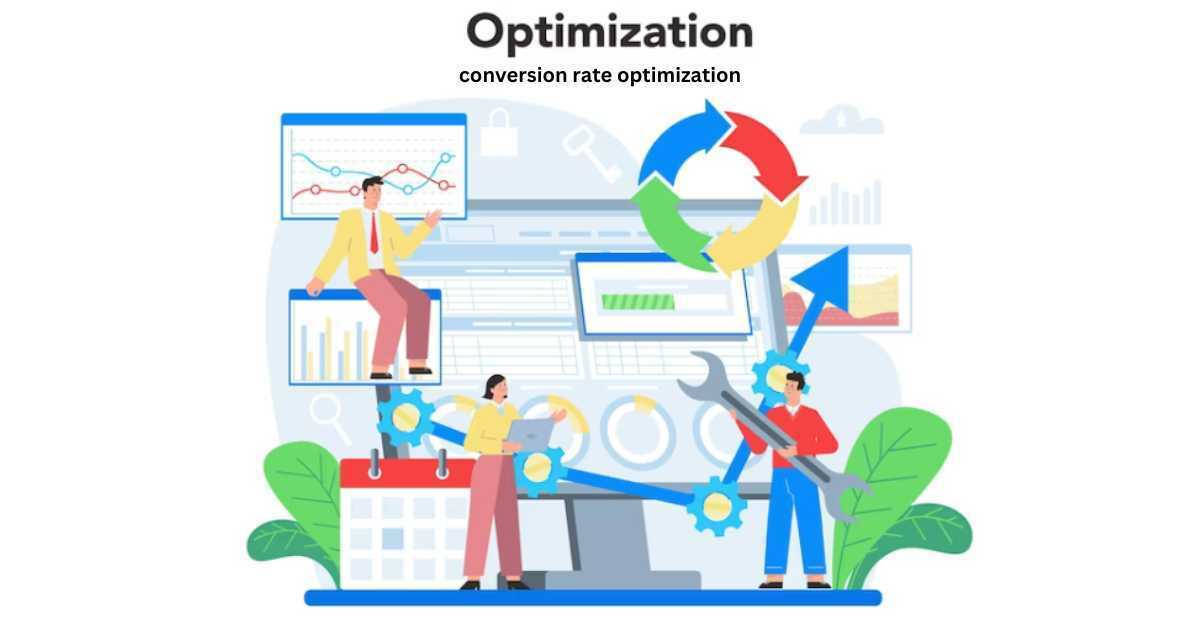One of the most important components of any profitable Internet business is conversion rate optimization (CRO). increasing the proportion of website visitors who complete a desired action, like making a purchase or taking out a form, is the process of increasing conversion rates. In this post, we’ll go through 5 Tips to Improve Your Conversion Rate Optimization, which will boost sales for your online business.
Understanding Conversion Rate Optimization
Conversion rate optimization is the practice of increasing the proportion of website visitors who finish a desired action, like making a purchase or filling out a form. (CRO). Knowing how your target audience behaves, making decisions on data, and constantly testing and enhancing your website are all parts of CRO.

“Unlock the Secret to Skyrocketing Conversion Rates with Fiverr’s Game-Changing Services!”
#Tip 1: Know Your Target Audience
Understanding your target audience is the first step in optimizing your conversion rate. They, who? What are the struggles and pains? What spurs them into action? Understanding your target market will help you develop a more focused and unique experience that speaks to their wants and preferences.
#Tip 2: Use Clear and Compelling Calls-to-Action
A call-to-action (CTA) is a button or link that prompts website visitors to take a specific action, such as “Buy Now” or “Sign Up Today”. The design and placement of your CTA can have a significant impact on your conversion rate. To improve your CRO, use clear and compelling CTAs that stand out on your website and communicate the value of taking action.
#Tip 3: Optimize Your Website for Mobile Devices
Mobile devices account for a significant portion of website traffic, and if your website is not optimized for mobile, you could be missing out on potential conversions. To improve your CRO, ensure that your website is mobile-friendly and optimized for a seamless mobile experience.
#Tip 4: Improve Website Loading Speed
The idea behind social proof is that when people witness others acting in a certain way, they are more inclined to follow suit. Utilize social proof by adding client reviews, recommendations, and social media posts to your website to increase conversion rates. The possibility of conversions can be increased by using these social proof components to assist develop trust and credibility with your target audience.
#Tip 5: Leverage Social Proof
The idea of social proof holds that people are more likely to act if they observe others doing the same. By integrating client feedback, testimonials, and social network posts on your website, you can increase your conversion rate optimization (CRO). These social proof components can support the development of trust and credibility with your target audience, which will increase the possibility of conversions.
Conclusion
Any successful online business must focus on increasing its conversion rate optimization. You can raise your CRO and eventually your online business revenue by knowing your target market, utilizing clear and engaging CTAs, optimizing your website for mobile devices, speeding up website loading, and utilizing social proof.
FAQs: 5 Tips to Improve Your Conversion Rate Optimization
Q. What is conversion rate optimization (CRO)?
A. Increasing the percentage of website visitors who complete a desired action, like making a purchase or filling out a form, is known as conversion rate optimization CRO.
Q. Why is it important to optimize my website for mobile devices?
A. Mobile devices account for a significant portion of website traffic, and if your website is not optimized for mobile, you could be missing out on potential conversions.
Q. How can I improve my website loading speed?
A. There are a variety of techniques you can use to increase the speed at which your website loads, including optimizing your images and videos, lowering the number of plugins and scripts, utilizing browser caching, utilizing a content delivery network (CDN), and minimizing HTTP requests. Additionally crucial are selecting a trustworthy web server and routinely checking the functionality of your website using programs like Google PageSpeed Insights or GTmetrix.
Q. What is the growth of conversion rate optimization?
A. More organizations are seeing the value of increasing their website’s conversion rates, which has led to a steady development in the field of conversion rate optimization (CRO). Companies who invest in CRO are more likely to see a big improvement in their conversion rates and income, according to a report by Econsultancy. The expansion of CRO is anticipated to continue as the internet market’s competition heats up.
Q. Which tools do you use for conversion rate optimization?
A. There are numerous tools available for conversion rate optimization, including A/B testing tools like Optimizely, VWO, or Google Optimize, heat mapping tools like Crazy Egg or Hotjar, user testing platforms like UserTesting or Userlytics, and analytics tools like Google Analytics or Kissmetrics. The choice of tools depends on your specific needs and budget.
Q. How does conversion rate optimization work?
A. Conversion rate optimization is the process of improving the percentage of website visitors who complete a desired action, such as making a purchase or filling out a form. It involves analyzing user behavior and data, creating hypotheses, testing different variations of website elements (such as headlines, calls-to-action, or page layouts), and measuring the results to identify the most effective strategies.
Q. What should you know about conversion rate optimization?
A. Conversion rate optimization is a data-driven strategy that calls for continual testing and experimentation in order to identify the best methods for raising conversion rates on your Website. It’s critical to comprehend your target market, their behavior, and the key performance indicators (KPIs) that are significant to your business. It’s also critical to regularly assess and review the functionality of your website to identify any areas that could be improved.
Q. What are the fundamentals of conversion rate optimization?
A. The fundamentals of conversion rate optimization include setting clear goals and KPIs, understanding your target audience, analyzing user behavior and data, creating hypotheses, testing different variations of website elements, measuring the results, and continuously improving based on the insights gained.
Q. Why is conversion rate optimization so important?
A. The ability for businesses to improve the operation of their websites, increase conversion rates, and ultimately increase revenue makes conversion rate optimization vital. Finding the most effective strategies for attracting and converting website visitors can help businesses improve their return on investment (ROI) and compete more successfully in the online market.
Q. What is meant by conversion rate optimization?
A. Conversion rate optimization (CRO) is the process of improving the percentage of website visitors who complete a desired action, such as making a purchase, filling out a form, or subscribing to a newsletter. It involves analyzing user behavior and data, creating hypotheses, testing different variations of website elements, and measuring the results to identify the most effective strategies.
Q. What is the short form of conversion rate optimization?
A. Conversion Rate Optimization is commonly known as CRO.
Q. Why is conversion Rate optimization important in SEO?
A. Because it helps companies increase their website’s user experience, engagement, and conversion rates—all of which search engines take into account when ranking websites—conversion rate optimization is crucial for SEO. Businesses may increase their online visibility, traffic, and sales by optimizing their websites for both users and search engines.
Q. What is the conversion rate formula?
A. The conversion rate is determined using the following formula:
The conversion Rate is calculated as follows: (Number of Conversions / Total Visitors) x 100%
The conversion rate would be as follows, for example, if your website had 500 visits and 50 of them made a purchase:
(50/500) x 100% = 10%
This indicates that 10% of the people who visited your website performed the desired action. (in this case, making a purchase).
Also, Read- “PPC on Google” Google AdWords Overview- Inorganic Search Result
Also, Read- The Benefits of Utilizing Web Analytics for Your Business
Also, Read- Keyword Match Types in Adwords as well as Keywords Research
Also, Read- Creating our First Responsive Search Ads Campaign with AdWords Bidding Strategies




